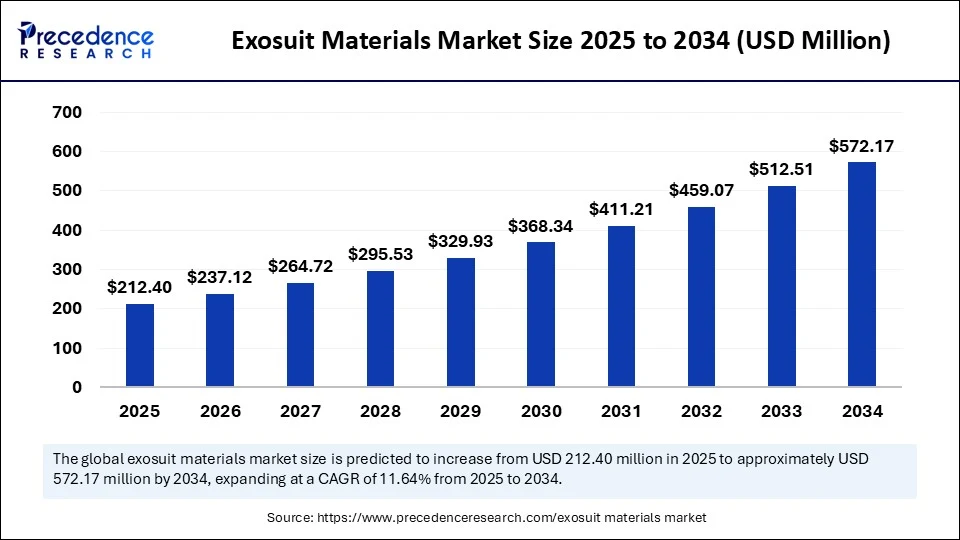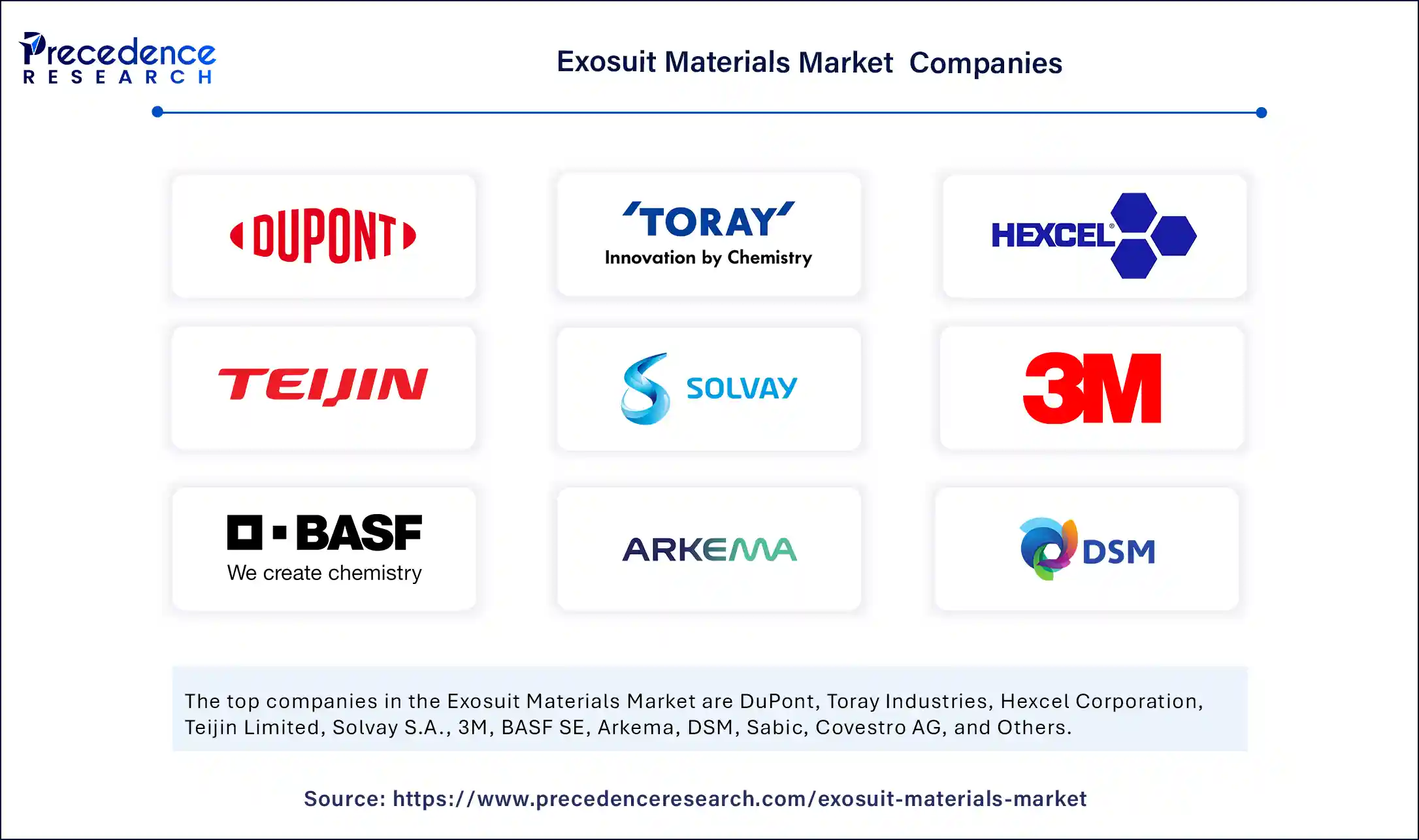Exosuit Materials Market Size to Surpass USD 572.17 Million by 2034
The global exosuit materials market size was valued at USD 190 25 million in 2024 and is predicted to hit around USD 572 17 million by 2034, growing at a CAGR of 11 64%.

Exosuit Materials Market Key Takeaways
- Valued at USD 190.25 million in 2024, the global exosuit materials market is set to grow to USD 572.17 million by 2034, with a projected CAGR of 11.64% from 2025 onward.
- North America emerged as the market leader in 2024, accounting for 37% of global revenue.
- Asia Pacific is positioned as the fastest-growing region through the forecast horizon.
- When segmented by material type, soft and flexible materials led with a 45% market share in 2024, while sensor-integrated materials are set to grow most rapidly.
- By suit type, soft exosuits held the dominant position at 53%, and hybrid designs are forecast to see the quickest growth.
- Within applications, the medical and rehabilitation sector claimed the highest share at 49%, whereas the industrial/occupational category is likely to grow most robustly.
- In 2024, hospitals and rehab centers were the top end-users, contributing 43% of market revenue, with manufacturing companies expected to register the highest growth rate.
What Role Does AI Play in Advanced Exosuit Materials?
Artificial intelligence is revolutionizing the exosuit materials industry by enabling more adaptable, intelligent, and efficient wearable systems. This enhances user comfort, performance, and safety, particularly in rehabilitation and healthcare. AI accelerates material innovation, allowing materials to be pre-designed for specific conditions and optimized for durability, flexibility, and weight.
In addition, AI algorithms are used to design and optimize exosuit materials. They can analyze vast datasets to identify the best materials and configurations for specific applications, improving performance and reducing costs.
Get Sample Link@ https://www.precedenceresearch.com/sample/6416
Market Overview
Soft fabrics dominated the material type with 45 percent share, while soft exosuits accounted for 53 percent of the market by suit type. Medical and rehabilitation use cases comprised 49 percent of the application market, and hospitals and rehab centers made up 43 percent of end‑user revenue in 2024. Geographically, North America was the largest regional market at 37 percent, while Asia‑Pacific is projected to be the fastest‑growing region over the forecast horizon.
Drivers
The heart of this market’s momentum lies in the increasing demand for mobility solutions that are user‑friendly, adaptable, and supportive. Aging societies in developed regions are driving growth in rehabilitation and assistive care, creating a strong need for soft, flexible exosuit materials that offer both support and comfort during physical recovery.
Meanwhile, industries—from manufacturing plants to construction sites—are exploring wearable assistance technologies to combat worker fatigue and reduce injury risk. Regulatory pressure to meet occupational safety standards has incentivized adoption of smart material solutions that can sense motion, posture, and force. The rise of sensor‑rich fabrics enables real‑time assistance and feedback to the wearer, increasing the sophistication of modern exosuits.
Lastly, government investment in assistive technology and collaborations between universities and industry have accelerated development of new materials—helping to bridge the gap between lab prototypes and real‑world application.
Opportunities
Asia‑Pacific represents one of the most compelling opportunity zones, where rising healthcare infrastructure, expanding industrial sectors, and rapidly aging populations converge. There, manufacturers can introduce affordable soft exosuit materials with localized design tailored to healthcare providers and mid‑sized industrial customers.
Cross‑sector integration is creating chance to pivot materials developed for one domain—say rehabilitation—into others such as logistics or military support. Startups that can develop modular, personalized exosuit materials will ride the wave of customization and bespoke user needs.
Sensors woven into materials facilitate integration with wearable electronics, enabling remote monitoring, predictive maintenance, and personalized therapy tracking—opening monetization paths beyond the hardware itself, into data and services. Hybrid materials that blend soft textiles with rigid frames can open new product categories: comfortable yet high‑performance exosuits for both clinical and industrial use.
Challenges
Despite the promise, several barriers must be overcome. Manufacturing costs for advanced sensor‐embedded fabrics remain high, limiting scalability. Regulatory pathways are complex—medical certification processes like FDA or CE approval take time and investment.
Durability remains a concern: flexible materials and sensors must endure repeated wear, sweat, washing, and mechanical stress while preserving function. User acceptance is also critical; devices must be comfortable, unobtrusive, and culturally acceptable in both vehicle assembly lines and clinical wards. Integrating intelligent materials into wearable systems demands power sources, data interfaces, and robust control units—adding complexity and potential failure points.
Recent Developments
In the past few years, companies specializing in soft robotics have launched exofabric lines embedding sensors for joint tracking and pressure detection. These materials are finding early traction in rehabilitation clinics and industrial pilots.
Hybrid design exosuits are gradually making their way into warehousing and automotive assembly pilots; blending rigid frames with soft, breathable liners for comfort and functional support.
Medical partnerships have led to formal trials: soft exosuits for gait rehabilitation in stroke, spinal injury, and post‑operative recovery patients are reporting promising preliminary results—faster progress, safer movement, and higher patient satisfaction.
In Asia, government programmes in South Korea, Japan, and China are funding R&D into indigenous exosuit materials with the goal of servicing large eldercare populations at lower cost.
Efforts to standardize testing and certification protocols are ramping up, paving the way for smoother commercialization.
Exosuit Materials Market Companies

- DuPont
- Toray Industries
- Hexcel Corporation
- Teijin Limited
- Solvay S.A.
- 3M
- BASF SE
- Arkema
- DSM
- Sabic
- Covestro AG
- Owens Corning
- Parker Hannifin
- Gore Fabrics (Gore-Tex)
- Lubrizol
- Eastman Chemical Company
- E-textiles by Myant Inc.
- StretchSense Ltd.
- Xsens Technologies
- Conductive Composites Co.
Market segment Covered in the Report
By Material Type
- Soft & Flexible Materials
- Textiles (Nylon, Polyester, Kevlar)
- Elastomers (Silicone, TPU, Neoprene)
- Smart Fabrics / E-textiles
- Rigid & Structural Materials
- Carbon Fiber Composites
- High-Strength Aluminum Alloys
- Titanium Alloys
- Engineering Plastics (Polycarbonate, PEEK)
- Sensor-Integrated Materials
- Piezoelectric Materials
- Graphene-based Materials
- Liquid Metal Alloys
- Flexible Printed Circuits (FPCs)
- Energy Storage Materials
- Thin-Film Batteries
- Solid-State Batteries
- Supercapacitor Materials
By Suit Type
- Soft Exosuits
- Fabric-based actuation systems
- Pneumatic / Hydraulic textiles
- Rigid Exoskeletons
- Powered upper/lower body frames
- Passive support structures
- Hybrid Designs
- Mixed soft–rigid architectures
By Application
- Medical & Rehabilitation
- Post-stroke therapy
- Spinal cord injury
- Elderly mobility assistance
- Defense & Military
- Load carriage
- Endurance enhancement
- Injury prevention
- Industrial / Occupational
- Logistics
- Construction
- Assembly lines
- Consumer & Sports
- Mobility aid for the elderly
- Athletic enhancement (early-stage)
By End-User
- Hospitals & Rehabilitation Centers
- Defense Organizations / Military
- Manufacturing Companies
- Construction Firms
- Individuals (Home Care / Personal Use)
By Region
- North America
- Europe
- Asia Pacific
- South America
- Middle East & Africa
Also Read@ https://www.precedenceresearch.com/
